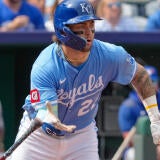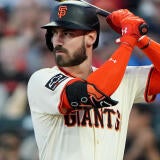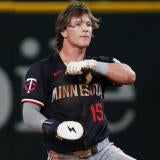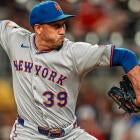Fantasy baseball waiver wire: Caminero's historic surge could reshape draft outlook
Plus, why Luis Morales' growth may lead to him becoming a must-add Fantasy option
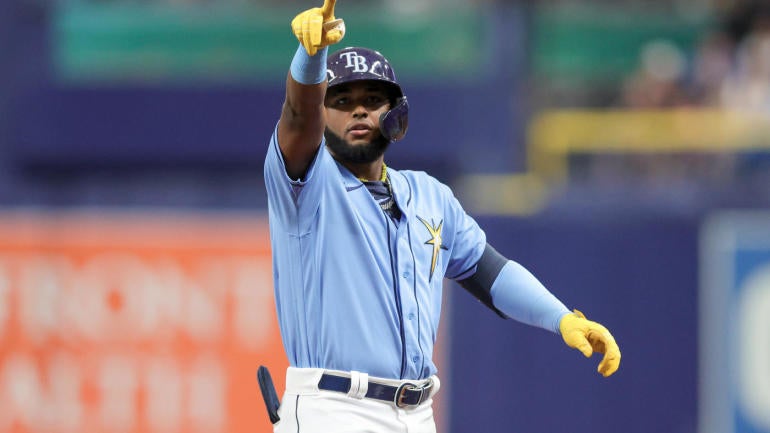
If you hit 40 homers in a season, you're already operating in rarified air. Over the past 15 seasons, only 42 players have managed the feat a total of 69 times, or about 4.5 times per season.
Doing it as a 21-year-old? That's even more rare. In the past 15 years, it has only happened once, when Ronald Acuna did it in 2019. But that actually overstates how common it is – before Acuna, it hadn't been done since 1953, and it had only happened three times in MLB history entering this season.
And Junior Caminero just made it four. With nearly four weeks left in the season, no less.
Caminero had another characteristically huge performance Tuesday against the Mariners, going 3 for 4 with the homer and four RBI, giving him 100 for the season. That 100-RBI mark isn't nearly as rare as the homer mark, but it's not exactly typical – among players 21 or younger, there have only been 10 100-RBI seasons dating back to 1960.
Can Camerino get to 50 homers? That might be asking too much, but Eddie Matthews' record for a player 21 or younger of 47 seems reasonable – and a repeat of Caminero's 12 August homers in September would get him to 50, too. What about 120 RBI? Again, it's asking a lot, but it's just about what he's on pace for right now.
And about a quarter of the way through the season, it didn't look like Caminero had any chance to do this. He was hitting just .235/.265/.412 with eight homers and just 20 RBI through his first 44 games of the season, when Caminero called up his personal hitting coach from the Dominican Republic to work on his swing. Camerino spent five days working with his coach in late May and started seeing almost immediate dividends, homering four times in four games to close out the month.
And he basically never stopped.
Caminero is hitting .275 since working with his hitting coach, with 32 homers and 80 RBI in 89 games. He still isn't a perfect hitter – his plate discipline isn't great, making up for subpar swing decisions (including a 15th percentile chase rate of 33.5%) – but Caminero has elite raw power and the fastest swing in baseball, and that's helped him overcome poor swing decisions.
Looking ahead at 2026 – something we'll increasingly do as September goes on – two questions are obvious:
1. How early should Caminero be drafted?
And …
2. How much better could he get?
We'll start with the first question: Caminero's gotta be a second-round pick, right? He's the No. 12 hitter in the FanGraphs Auction Calculator tool before his 40th homer and 100th RBI of the season are accounted for. I don't think any of the 11 players ahead of him are likely to be drafted after him – Trea Turner and Kyle Schwarber are the possible exceptions, given their age and Schwarber's DH-only status for 2026. There are a few players ranked behind Caminero I'd likely take ahead of him – Corbin Carroll and Julio Rodriguez seem like obvious candidates, and I'd probably still rank Kyle Tucker and Ronald Acuna ahead of him, too – but I still think you're taking the 22-year-old coming off a historic power season in the second round.
The question then becomes, "Well, how much better can Caminero get?" It would be weird for his age-21 season to represent his peak, as good as he's been. But what does the step forward look like for a guy already generating nearly top-of-the-scale quality of contact?
The obvious place to start would be with the swing decisions. Caminero manages to make contact at about an average rate despite his swing decisions, and obviously, he does a lot of damage when he does make contact. But there are plenty of mis-hits here – his 8.5 % pop-up rate is higher than the league average, as is his 46.3% groundball rate; his 19.3% line drive rate is also alarmingly low, helping explain why a guy who strikes out less often than league average and punishes the ball like Caminero does is hitting just .259.
Caminero has probably maxed out what he can reasonably do as a power hitter, which is not the same thing as saying 2025 will be his career-high for homers. There is room for an outlier season where he tops 50, but he just probably can't reasonably expect better than his current 25.5% HR/FB rate as a baseline when he's within one percentage point of Giancarlo Stanton's career mark. But he could tighten up his swing a bit more, hit more line drives and lower fly balls, and hit for a better batting average without sacrificing power. This is probably the biggest limitation in his swing right now, as seen by his second-percentile launch angle sweet spot rate -- which basically means he hits a lot of balls really high or really low, neither of which is especially conducive to productive hitting.
How often do hitters improve dramatically on that specific skill? Well, the good news is we have a few good examples to point to in recent years. From 2021 through 2024, there were 17 hitters who had a launch-angle sweet spot below 29% – Caminero is at 27.8% this season – and all but three were at least above 30% the following season. On average, though, 17 hitters improved from 28.1% to 32% the following season, and that includes some notable improvers like Zach Neto (29% to 37.4%), Corbin Carroll (27.8% to 33.1%), and Randy Arozarena (28.4% to 34.2%) this season.
One other comp for Caminero I have used for a while is Marcell Ozuna. They have very visually similar swings to my eye, and Ozuna has a similar "looseness" to his swing, which has led to inconsistent production in his career. He was routinely in the 30-33% range in launch-angle sweet spot early in his career before making a leap to 39.1% in 2020 and staying north of 34% in four of five seasons since. Caminero is a more gifted hitter than Ozuna ever was, and Ozuna put up some pretty impressive seasons when he finally figured it all out.
Caminero could be even better. I'm not saying I expect him to hit .290 next season, but I do think it's something he could be capable of without having to sacrifice power. And if you're talking about how a player with basically zero stolen base upside could force his way into the first-round discussion, that's the path. Caminero has that kind of upside, and there aren't many players we can say that about.
Here's what else you need to know about from Tuesday's action around MLB:
Wednesday's top waiver-wire targets
Luis Morales, SP, Athletics (60%) – I ran out of time and space to write about Morales in the weekend recap yesterday, but he deserves a second look. Through his first five starts, Morales looked like an interesting live-armed young pitcher, but one who wasn't quite polished enough to be a must-add option for Fantasy. But this weekend, I think he leapt over that bar with his eight-strikeout showing against the Cardinals. He generated double-digit swinging strikes for the second start in a row, this time with a career-high 12, and really flashed upside with his breaking balls for the first time. Morales' sweeper, a low-80s bender with a huge amount of horizontal break, generating five whiffs on nine swings; his slider, a harder, more vertically oriented pitch, got four whiffs on as many swings. The fastball is hard but firm, and the changeup is generating plenty of weak swings but not necessarily whiffs yet, so if the two breakers can miss bats like that consistently, the whole profile looks a lot more interesting. I'm still a little bit skeptical of Morales, whose minor league track record is more "pretty good" than dominant, but the growth he's shown so far is eye-opening.
Cade Cavalli, SP, Nationals (27%) – I still think Cavalli is more "interesting" than "good" these days, but darn it if I don't find him extremely interesting right now. He's got a good fastball and a great curveball, and while that combo hasn't been quite enough for him yet, you can see signs of how it could – the consecutive quality starts against the Phillies a few weeks back and now this one. It wasn't quite a quality start as he was pulled after five innings, but Cavallie did get more than a strikeout per inning while throwing at least five innings for the first time, while showing off a balanced five-pitch mix, with 10 changeups and 10 cutters. He missed a few bats with both and limited hard contact well, and if those pitches can help him handle lefties better, he could take a step forward down the stretch. There's clearly talent here, and he is potentially a two-start pitcher against the Marlins and Pirates next week, so he could be pretty useful.
Robby Snelling, SP, Marlins (20%) – Let's get speculative. The Marlins have recently lost Ryan Gusto, Janson Junk, and Edward Cabrera to the IL, and Adam Mazur hasn't looked like he belongs in an MLB rotation, so they certainly have a need in the rotation even when Ryan Weathers returns – which could be next week, if you've got an IL spot to play with. Snelling's prospect star is back on the rise as he has a 1.38 ERA with a 30.2% strikeout rate as a 21-year-old at Triple-A this season, thanks at least in part to a near-2-mph jump in fastball velocity. He's throwing 94-plus from the left side and surely doesn't have much left to prove in the minors. I suppose the Marlins don't have to add Snelling to the active roster, but I'd hope they want to see what he can do before an offseason where they have some big decisions to make about the front of their rotation. Snelling showing he belongs could help make those decisions easier, and I suspect we will see him here shortly.
Owen Caissie, OF, Cubs (24%) – Let's go mostly speculative here as well. Kyle Tucker left Tuesday's game with a calf injury and will be off until at least Friday before the team decides on a path forward. Caissie was sent back down to Triple-A for Kevin Alcantara when rosters expanded, but if Tucker does have to miss significant time down the stretch, it might make more sense to go back to Caissie, who was both more productive at Triple-A and is the more highly regarded outfield prospect in the Cubs system. They could opt to go with Alcantara, of course, but if Tucker does have to miss time, I would bet on Caissie getting called up to play regularly ahead of Alcantara. And that could be very impactful for the stretch run.

